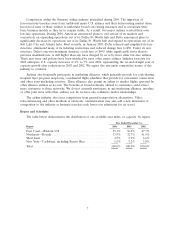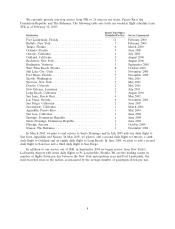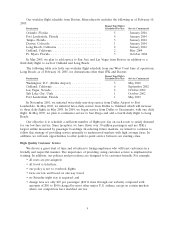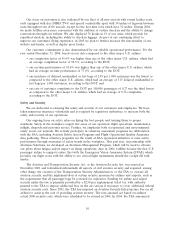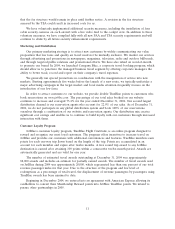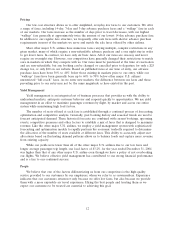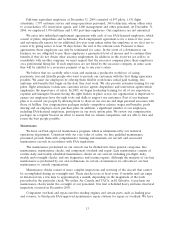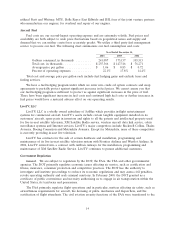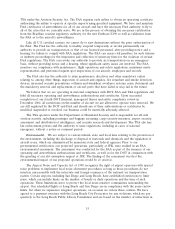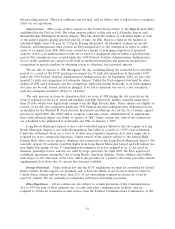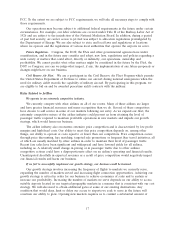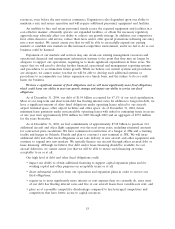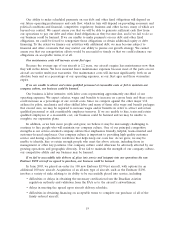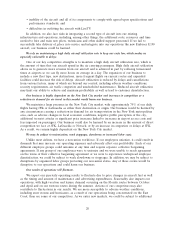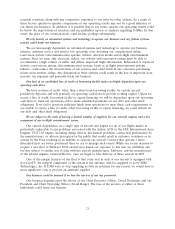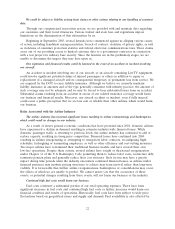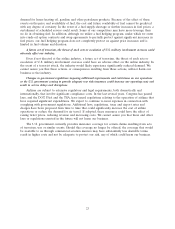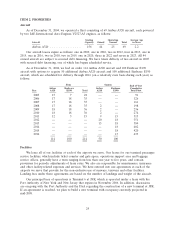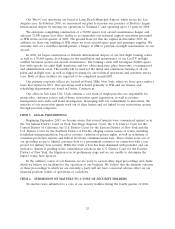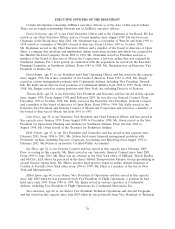JetBlue Airlines 2004 Annual Report Download - page 25
Download and view the complete annual report
Please find page 25 of the 2004 JetBlue Airlines annual report below. You can navigate through the pages in the report by either clicking on the pages listed below, or by using the keyword search tool below to find specific information within the annual report.FCC. To the extent we are subject to FCC requirements, we will take all necessary steps to comply with
those requirements.
Our operations may become subject to additional federal requirements in the future under certain
circumstances. For example, our labor relations are covered under Title II of the Railway Labor Act of
1926 and are subject to the jurisdiction of the National Mediation Board. In addition, during a period
of past fuel scarcity, air carrier access to jet fuel was subject to allocation regulations promulgated by
the Department of Energy. We are also subject to state and local laws and regulations at locations
where we operate and the regulations of various local authorities that operate the airports we serve.
Future Regulation. Congress, the DOT, the FAA and other governmental agencies have under
consideration, and in the future may consider and adopt, new laws, regulations and policies regarding a
wide variety of matters that could affect, directly or indirectly, our operations, ownership and
profitability. We cannot predict what other matters might be considered in the future by the FAA, the
DOT or Congress, nor can we judge what impact, if any, the implementation of any future proposals or
changes might have on our business.
Civil Reserve Air Fleet. We are a participant in the Civil Reserve Air Fleet Program which permits
the United States Department of Defense to utilize our aircraft during national emergencies when the
need for military airlift exceeds the capability of military aircraft. By participating in this program, we
are eligible to bid on and be awarded peacetime airlift contracts with the military.
Risks Related to JetBlue
We operate in an extremely competitive industry.
We currently compete with other airlines on all of our routes. Many of these airlines are larger
and have greater financial resources and name recognition than we do. Several of these competitors
have chosen to add service in some of our markets following our entry. As we expand our fleet, the
extremely competitive nature of the airline industry could prevent us from attaining the level of
passenger traffic required to maintain profitable operations in new markets and impede our growth
strategy, which would harm our business.
The airline industry also encounters extensive price competition and is characterized by low profit
margins and high fixed costs. Our ability to meet this price competition depends on, among other
things, our ability to operate at costs equal to or lower than our competitors. Price competition occurs
through price discounting, fare matching, targeted sale promotions or frequent flyer travel initiatives, all
of which are usually matched by other airlines in order to maintain their level of passenger traffic.
Recent fare sales have been significant and widespread and have lowered yields for all airlines,
including us. A relatively small change in pricing or in passenger traffic due to other airlines’
competitive actions could have a disproportionate effect on an airline’s operating and financial results.
Unanticipated shortfalls in expected revenues as a result of price competition would negatively impact
our financial results and harm our business.
If we fail to successfully implement our growth strategy, our business could be harmed.
Our growth strategy involves increasing the frequency of flights to markets we currently serve,
expanding the number of markets served and increasing flight connection opportunities. Achieving our
growth strategy is critical in order for our business to achieve economies of scale and to sustain or
increase our profitability. Increasing the number of markets we serve depends on our ability to access
suitable airports located in our targeted geographic markets in a manner that is consistent with our cost
strategy. We will also need to obtain additional gates at some of our existing destinations. Any
condition that would deny, limit or delay our access to airports we seek to serve in the future will
constrain our ability to grow. Opening new markets requires us to commit a substantial amount of
17


